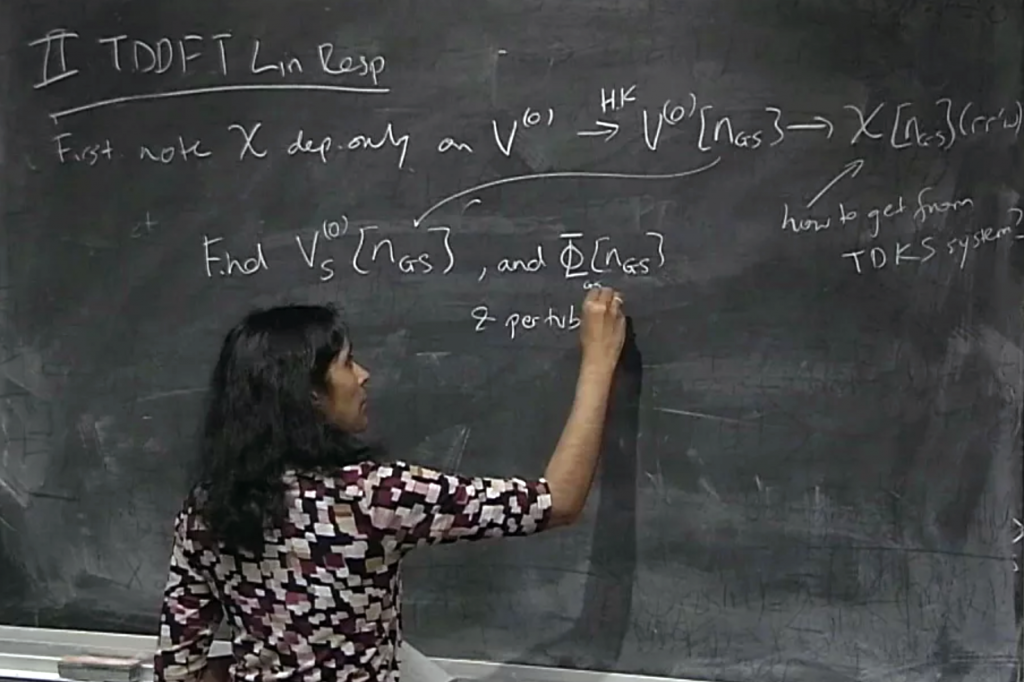Projects
We work on fundamental development in time-dependent density functional theory, coupled electron-ion motion, and methods to include photons.

Time-dependent density functional theory
Focusing purely on the electronic problem, with time-dependent density functional theory (TDDFT), we investigate properties of the exact functionals in order to guide the development of accurate approximations e.g. including memory-dependence, from non-adiabatic effects in the linear response regime, to how memory affects species in intense fields. This has a wide range of implications and applications: electronic excitation energies and spectra, double excitations, highly excited Rydberg states, quantum control in intense fields.
Recent Key Publications
- Perspective: Fundamental aspects of time-dependent density functional theory, N. T. Maitra, J. Chem. Phys. 144, 220901 (2016), journal version.
- Charge transfer in time-dependent density functional theory, N. T. Maitra, J. Phys. Condens. Matt. 29, 423001 (2017), arXiv version, journal version.
- Exact time-dependent exchange-correlation potential in electron scattering processes, Y. Suzuki, L. Lacombe, K. Watanabe, and N. T. Maitra, Phys. Rev. Lett. 119, 263401 (2017), arXiv version, journal version.
- Density-matrix coupled time-dependent exchange-correlation functional approximations, L. Lacombe, N. T. Maitra, J. Chem. Theory and Comput. 15, 1672 (2019), arXiv version, journal version.
Exact factorization approach
With coupled electron-ion motion, we have been developing the exact factorization approach in several directions, including exploring numerical stability of the exact equations, and understanding what features of the exact potentials and equations need to be captured by approximations in order to describe wavepacket branching and decoherence, in the presence or absence of external fields. We are also applying mixed quantum-classical methods derived from the approach, and developing new ones.
Recent Key Publications
-
On the numerical solution of the exact factorization equations, G. H. Gossel, L. Lacombe, N.T. Maitra, J. Chem. Phys. 150 154112 (2018), journal version
- A study of the decoherence correction derived from the exact factorization approach for non-adiabatic dynamics, P. Vindel Zandbergen, L. M. Ibele, J-K. Ha, S.-K. Min, B. F. E. Curchod, J. Chem. Theory Comput. 17, 3852 (2021), journal version, arxiv version
Polaritonic chemistry
Manipulating molecules by taking advantage of the strong light-matter coupling induced from confinement has given rise to the field of polaritonic chemistry, and we have been investigating these phenomena through an extension of the exact factorization approach to include photons, and through applying Ehrenfest methods for multi-mode situations.
Recent Key Publications
- Effect of Many Modes on Self-Polarization and Photochemical Suppression in Cavities, N. M. Hoffmann, L. Lacombe, A. Rubio, N. T. Maitra, J. Chem. Phys. 153, 104103 (2020), journal version, arXiv version
- Exact Potential Energy Surface for Molecules in Cavities, L. Lacombe, N. M. Hoffmann, and N. T. Maitra, Phys. Rev. Lett. 123, 083201 (2019), journal version, arXiv version
Embedding methods
We are also looking at electronic embedding methods developed from the exact factorization.
Recent Key Publications
- Embedding via the Exact Factorization Approach, L. Lacombe and N. T. Maitra, Phys. Rev. Lett. 124, 206401 (2020), journal version, arXiv version